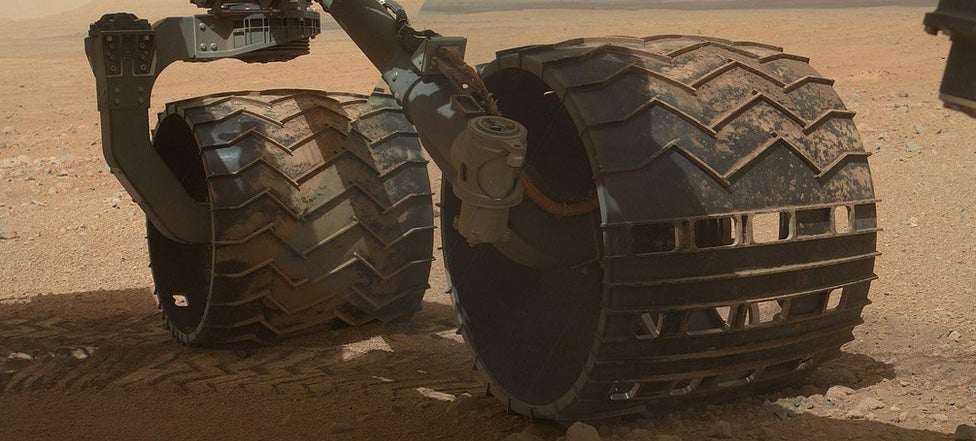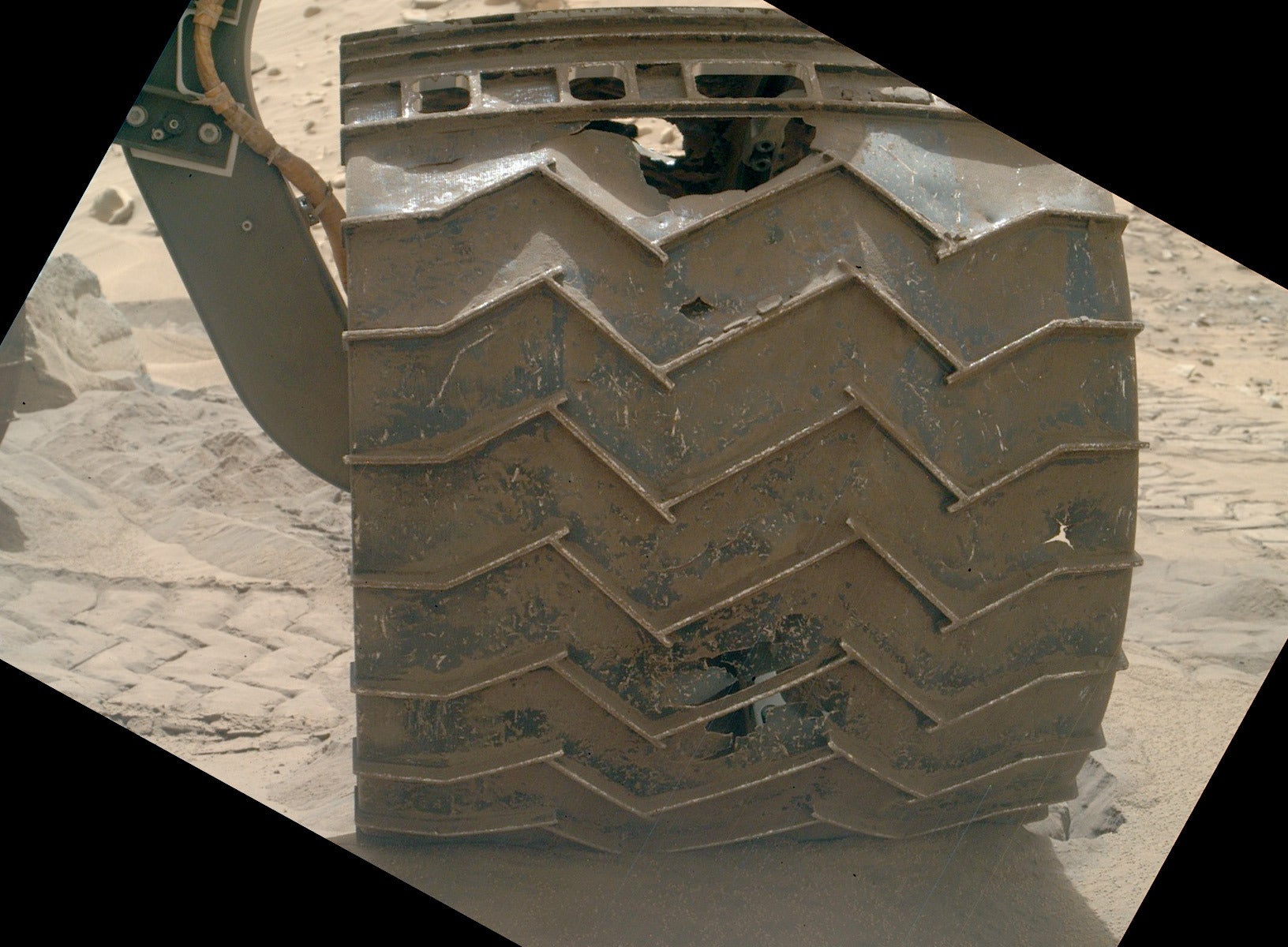Welcome to DU!
The truly grassroots left-of-center political community where regular people, not algorithms, drive the discussions and set the standards.
Join the community:
Create a free account
Support DU (and get rid of ads!):
Become a Star Member
Latest Breaking News
General Discussion
The DU Lounge
All Forums
Issue Forums
Culture Forums
Alliance Forums
Region Forums
Support Forums
Help & Search
Science
Related: About this forumCuriosity's Wheels Are Falling Apart (And How We Can Solve It)


There are holes in Curiosity wheels. There have always been holes — the rover landed with twelve holes deliberately machined in each wheel to aid in rover navigation. But there are new holes now: punctures, fissures, and ghastly tears.
The holes in Curiosity's wheels have become a major concern to the mission, affecting every day of mission operations and the choice of path to Mount Sharp. Yet mission managers say that, so far, the condition of the wheels has no effect on the rover's ability to traverse Martian terrain. If the holes are not causing problems, why the rerouting? Is the wheel damage a big deal or not?
I've been asked a lot of questions about the wheels since we noticed the first rip on sol 411, and I've received many requests for posts specifically addressing the wheel damage problem. At first, I dismissed people's concerns, because the mission seemed unconcerned. But within a few months, the mission started becoming more alarmed by a sudden increase in the rate of damage. They had to form a "Tiger Team" to understand what was causing the more-than-anticipated damage and to determine how best to address the problem. Their work isn't over, but the Tiger Team had a major review meeting on August 7, and last week I had a lengthy conversation with Project Manager Jim Erickson about the mission's status. I'm glad to finally be able to address your questions about the wheels.
http://gizmodo.com/curiositys-wheels-are-falling-apart-and-how-we-can-sol-1626826935
The holes in Curiosity's wheels have become a major concern to the mission, affecting every day of mission operations and the choice of path to Mount Sharp. Yet mission managers say that, so far, the condition of the wheels has no effect on the rover's ability to traverse Martian terrain. If the holes are not causing problems, why the rerouting? Is the wheel damage a big deal or not?
I've been asked a lot of questions about the wheels since we noticed the first rip on sol 411, and I've received many requests for posts specifically addressing the wheel damage problem. At first, I dismissed people's concerns, because the mission seemed unconcerned. But within a few months, the mission started becoming more alarmed by a sudden increase in the rate of damage. They had to form a "Tiger Team" to understand what was causing the more-than-anticipated damage and to determine how best to address the problem. Their work isn't over, but the Tiger Team had a major review meeting on August 7, and last week I had a lengthy conversation with Project Manager Jim Erickson about the mission's status. I'm glad to finally be able to address your questions about the wheels.
http://gizmodo.com/curiositys-wheels-are-falling-apart-and-how-we-can-sol-1626826935
InfoView thread info, including edit history
TrashPut this thread in your Trash Can (My DU » Trash Can)
BookmarkAdd this thread to your Bookmarks (My DU » Bookmarks)
5 replies, 1135 views
ShareGet links to this post and/or share on social media
AlertAlert this post for a rule violation
PowersThere are no powers you can use on this post
EditCannot edit other people's posts
ReplyReply to this post
EditCannot edit other people's posts
Rec (6)
ReplyReply to this post
5 replies
 = new reply since forum marked as read
Highlight:
NoneDon't highlight anything
5 newestHighlight 5 most recent replies
= new reply since forum marked as read
Highlight:
NoneDon't highlight anything
5 newestHighlight 5 most recent replies
Curiosity's Wheels Are Falling Apart (And How We Can Solve It) (Original Post)
pokerfan
Aug 2014
OP
monmouth3
(3,871 posts)1. "Made In China." I have no doubt about that...LOL..n/t
exboyfil
(17,862 posts)2. In engineering the joke is that you make beer cans
out of aluminum. You want it to last then use steel (yes I know weight limitations).
Should have had some sort of ceramic cover on wheels.
"When in doubt make it sturdy out of something you know"
xocet
(3,871 posts)3. True, but there were other concerns that are mentioned in the article....
...
5. Why didn't they foresee this problem?
There were several factors that drove them to design the wheels to be as lightweight as possible. The large size of the wheels means that very slight design changes add a substantial amount of mass. Increasing wheel thickness by one millimeter would add 10 kilograms to the rover's total mass. But total system mass wasn't the only constraint. Erickson explained that a major constraint arose from a tricky moment in the landing sequence, at the moment that the wheels deployed, while the rover was suspended from the bridle underneath the descent stage. The wheels' sudden drop imparted substantial forces on the mobility system, and keeping wheel mass as light as possible reduced those forces to manageable ones. There were other factors that made it important to keep wheel mass low.
So the wheels needed to be as light as possible while still being able to do their job, but as to their job: "We misunderstood what Mars was," Erickson said. "Strongly cemented ventifacts are not something that we saw on Mars before." They designed Curiosity to handle all the challenges that Spirit and Opportunity had experienced, especially sand, which Curiosity traverses substantially better than her predecessors. "This vehicle is able to get itself out of situations that MER couldn't; it's got more flotation than MER had by a substantial margin." They designed Curiosity to handle the sand traps, flat bedrock, and rocks-perched-on-sand landscapes seen by all the previous landers. They just didn't imagine the possibility of the peculiar and never-before-seen terrain type that they found in Gale crater. "There are [places] on Earth that do have these sharp ventifacts, but we hadn't seen them on Mars and we didn't test against them," Erickson said.
...
http://gizmodo.com/curiositys-wheels-are-falling-apart-and-how-we-can-sol-1626826935
5. Why didn't they foresee this problem?
There were several factors that drove them to design the wheels to be as lightweight as possible. The large size of the wheels means that very slight design changes add a substantial amount of mass. Increasing wheel thickness by one millimeter would add 10 kilograms to the rover's total mass. But total system mass wasn't the only constraint. Erickson explained that a major constraint arose from a tricky moment in the landing sequence, at the moment that the wheels deployed, while the rover was suspended from the bridle underneath the descent stage. The wheels' sudden drop imparted substantial forces on the mobility system, and keeping wheel mass as light as possible reduced those forces to manageable ones. There were other factors that made it important to keep wheel mass low.
So the wheels needed to be as light as possible while still being able to do their job, but as to their job: "We misunderstood what Mars was," Erickson said. "Strongly cemented ventifacts are not something that we saw on Mars before." They designed Curiosity to handle all the challenges that Spirit and Opportunity had experienced, especially sand, which Curiosity traverses substantially better than her predecessors. "This vehicle is able to get itself out of situations that MER couldn't; it's got more flotation than MER had by a substantial margin." They designed Curiosity to handle the sand traps, flat bedrock, and rocks-perched-on-sand landscapes seen by all the previous landers. They just didn't imagine the possibility of the peculiar and never-before-seen terrain type that they found in Gale crater. "There are [places] on Earth that do have these sharp ventifacts, but we hadn't seen them on Mars and we didn't test against them," Erickson said.
...
http://gizmodo.com/curiositys-wheels-are-falling-apart-and-how-we-can-sol-1626826935
defacto7
(13,485 posts)4. I don't suppose calling Les Schwab
would do any good.
![]()
Javaman
(62,521 posts)5. Simple solution...
park it in a spot where they can maximize science from a single location.
tires wear out. just the facts.